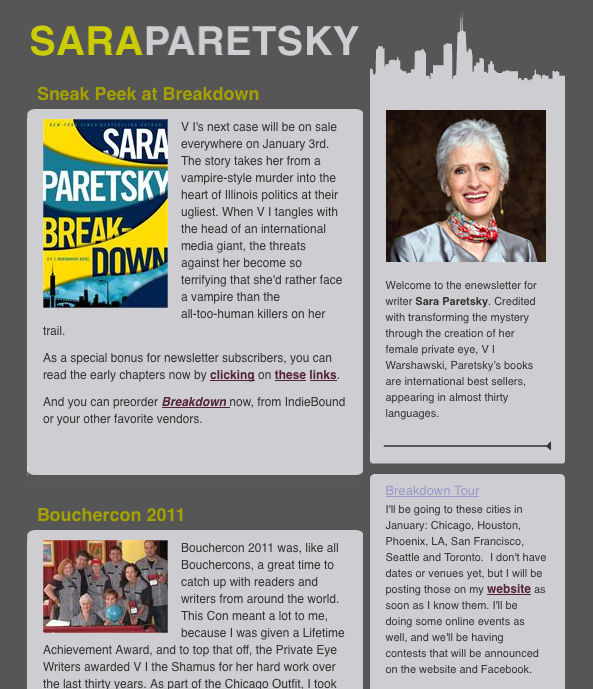 I’m often asked by my author clients if they should include email newsletters as part of their self-promotion strategy. The answer is always an emphatic yes—if done the right way. Below, I identify tips to help you choose the right platform, build your list, and send out emails that will engage your readers—and never annoy them.
I’m often asked by my author clients if they should include email newsletters as part of their self-promotion strategy. The answer is always an emphatic yes—if done the right way. Below, I identify tips to help you choose the right platform, build your list, and send out emails that will engage your readers—and never annoy them.
Choosing the Right Platform
As with pretty much any Web service, there are no shortage of options for email newsletters. Campaign Monitor is, in my opinion, the best email newsletter management system available. Newsletters are built and sent all through a simple Web interface, and after sending a newsletter, you can access robust results about who is reading your newsletters and what they are clicking on.
But I think Campaign Monitor’s best feature is the control it gives you over creating a unique template. If you have Web design experience, you have complete control over the HTML structure and style sheets. If you’re not, their robust template builder is a powerful tool that allows you to create a custom template through your browser. You can choose to pay monthly or by campaign. And prices vary based on the size of your list and number of times you wish to send.
MailChimp is another popular Web-based email newsletter service. It offers many of the same features as Campaign Monitor, but I have found that it is a little bit more difficult to create a custom design or break out of their template designs offerings. But they are also less expensive than Campaign Monitor.
Building Your List
The key here is not to be a jerk. Because if you simply upload your entire address book into your email newsletter platform, that is exactly what you’re being. The CAN-SPAM laws define explicit rules for sending emails. Specifically, you must include a valid postal address, give the option to opt out of your list, and honor those requests promptly.
But most reputable email newsletter systems go further, requiring you to establish some sort of explicit permission before using their service. A good rule of thumb for whether your contacts are indeed kosher are if they are: obtained through a subscription form or an opt-in form; if they are emails from customers whom you have done business with during the past two years; or from business cards that you have received direct from the source. It might be tempting to dump in all the emails you can find, but keep in mind that you will do yourself no favors by sending people who haven’t given your consent unsolicited emails.
What Kind of Content?
 Your templates must be built around the content that you include. So, consider the type of information you want to include and remember that you should never have more than 300 words per newsletter.
Your templates must be built around the content that you include. So, consider the type of information you want to include and remember that you should never have more than 300 words per newsletter.
Consider creating unique templates for different types of content. If you are sending out an announcement exclusively to promote an author appearance or promotion, this might be best handled by a no-nonsense one-column template, like this one that HarperOne created to promote their top 10 Easter books.
If you have a lot of different pieces of information to include, you might want to have a template that includes different blocks and columns, like this one veteran mystery author Sara Paretsky used to promote the launch of her new book (above). Front-and-center is the cover and description. News about a recent appearance is in the block below. To the right, she uses her portrait and description to orient subscribers to her site and brand. Below that, she promotes her tour dates. Remember that copy works best in short blocks accompanied by a link.
 Gretchen Rubin has done an exemplary job communicating and connecting with her readers through her email newsletter. Rubin offers a variety of options for email communication, depending on the level of engagement her readers wish to have. There is a monthly newsletter (with content like hot topics, useful tips, resolutions, and always an invitation to connect). There are daily inspirational quotes. Plus, there’s the opportunity to engage further as a super fan, join the book club, or just receive blog posts by email.
Gretchen Rubin has done an exemplary job communicating and connecting with her readers through her email newsletter. Rubin offers a variety of options for email communication, depending on the level of engagement her readers wish to have. There is a monthly newsletter (with content like hot topics, useful tips, resolutions, and always an invitation to connect). There are daily inspirational quotes. Plus, there’s the opportunity to engage further as a super fan, join the book club, or just receive blog posts by email.
Engage Your Readers
This is an opportunity to engage your readers beyond the written page. Write from the heart and speak directly to your readers. Include information they are not likely to find in any interview or publisher materials. Invite them to engage with you through social media or email. Done right, your newsletter will help you connect with readers on another level and inspire them to delve deeper into your work.
Lisa Hazen is a Chicago-based Web Designer specializing in author sites. You should totally subscribe to her newsletter. You can find her on Twitter, Facebook, or the WWW. [email protected]